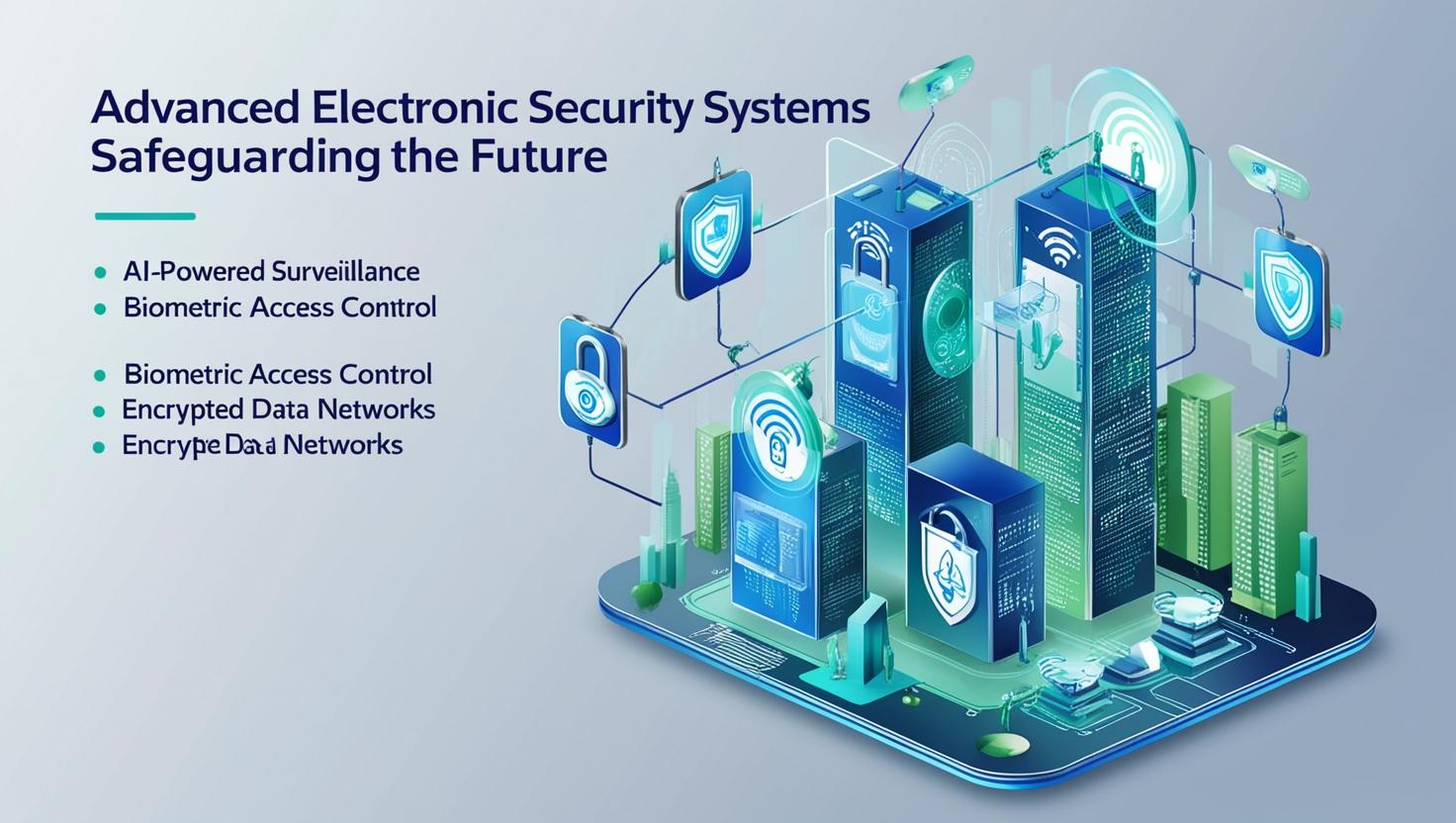The security landscape has evolved rapidly over the last few decades, particularly with the integration of new technologies. The advent of electronic security systems has revolutionized how homes, businesses, critical infrastructure, and public spaces are safeguarded against various threats. From surveillance cameras to access control systems, the rise of electronic security systems has greatly enhanced the ability to monitor, manage, and protect environments in real-time. The global market for electronic security systems continues to experience significant growth, driven by technological innovations and the increasing demand for enhanced security solutions across different sectors.
This article delves into the various factors driving the electronic security systems market, exploring the technologies that are shaping the industry, the evolving consumer needs, and the challenges faced by the sector. Additionally, we will examine the emerging trends that are poised to redefine the future of electronic security systems.
1. Overview of the Electronic Security Systems Market
The electronic security systems market refers to the use of electronic devices and technologies to protect people, property, and assets from threats like theft, vandalism, unauthorized access, and other forms of crime. These systems include surveillance cameras, alarms, access control systems, biometrics, fire safety systems, and intrusion detection systems, among others.
As threats to security become more sophisticated and diverse, the demand for advanced electronic security solutions has surged. From residential properties to large enterprises and government buildings, organizations and individuals are investing in electronic security systems to provide real-time monitoring, incident detection, and automated responses to security breaches.
This growth is driven by increasing concerns about safety, rising crime rates, the demand for automation in security systems, and technological innovations in security solutions.

2. Key Components of Electronic Security Systems
Electronic security systems are composed of various interconnected components designed to protect physical spaces from threats. These components include:
- Surveillance Systems: Surveillance systems, particularly closed-circuit television (CCTV) cameras, have become a cornerstone of modern security strategies. These systems use cameras, digital recording devices, and software to capture, record, and monitor video footage in real-time. Advances in high-definition cameras, 4K resolution, motion detection, and remote access capabilities have greatly improved the effectiveness of surveillance systems.
- Access Control Systems: Access control systems are designed to regulate who can enter or exit a facility, room, or building. These systems include traditional key card readers, biometric access systems (fingerprint, retina, facial recognition), and mobile-enabled access systems. Access control ensures that only authorized individuals can gain entry, and integrates seamlessly with surveillance systems for a holistic security approach.
- Intrusion Detection Systems: Intrusion detection systems (IDS) monitor physical entry points, such as doors, windows, and gates, to detect unauthorized access. These systems typically include motion sensors, door/window contact sensors, and glass-break detectors. They can trigger alarms or send notifications to security personnel if suspicious activity is detected.
- Fire and Environmental Monitoring Systems: Fire safety systems are critical for protecting both people and property from the dangers of fire. These systems include smoke detectors, heat sensors, fire alarms, and emergency lighting. Similarly, environmental monitoring systems can detect leaks, gas emissions, and other hazardous conditions, allowing for rapid intervention.
- Alarm Systems: Alarm systems are a fundamental component of electronic security, offering real-time alerts when a security breach or emergency event occurs. These can include audible sirens, visual signals, and digital alerts sent to security teams or mobile devices. Alarms are often integrated with other security systems for automatic response.
Download PDF Brochure @
https://www.marketsandmarkets.com/pdfdownloadNew.asp?id=205573901
3. Driving Factors Behind the Growth of the Electronic Security Systems Market
Several factors are driving the growth of the electronic security systems market:
- Increasing Security Threats: With the rise in crime rates, terrorism, and cyber threats, there is an ever-growing need for robust security solutions. Traditional security methods no longer suffice, making way for technologically advanced security systems that offer real-time monitoring, detection, and intervention.
- Adoption of Smart and Automated Technologies: The increasing integration of smart technologies has revolutionized the way security systems function. IoT-enabled devices, artificial intelligence (AI), machine learning (ML), and cloud-based platforms are improving the functionality and efficiency of electronic security systems. Automation allows for faster response times, predictive analytics, and more accurate threat detection.
- Surge in Demand for Surveillance Systems: With the need for monitoring public spaces, offices, and retail environments, surveillance systems have gained significant popularity. The rise in urbanization and the expansion of commercial and residential properties have driven the demand for effective surveillance systems.
- Focus on Workplace and Public Safety: Governments and private organizations are increasingly prioritizing workplace safety and public protection. This has led to an increase in demand for integrated security systems that provide comprehensive protection across various sectors, including healthcare, education, transportation, and critical infrastructure.
- Integration of Biometric Technologies: Biometric authentication methods like fingerprint, facial recognition, and iris scanning have gained traction due to their high level of security. These methods offer accurate identification and access control, making them essential in sectors such as banking, healthcare, and government services.
- Government Regulations and Standards: Governments around the world are imposing regulations and standards requiring businesses and public entities to adopt electronic security systems. These regulations often focus on protecting critical infrastructure, personal data, and sensitive information, driving the adoption of advanced security systems.
4. Emerging Technologies in Electronic Security Systems
The evolution of electronic security systems is largely driven by emerging technologies. Some of the most notable technologies shaping the future of security systems include:
- Artificial Intelligence (AI) and Machine Learning (ML): AI and ML algorithms are being integrated into security systems to enhance threat detection, automate responses, and predict potential security risks. For example, AI-powered surveillance cameras can automatically detect suspicious behavior or abnormal patterns in crowds, providing early warnings of potential threats.
- Internet of Things (IoT): The IoT has enabled greater connectivity between security devices, creating smart security ecosystems. IoT-based security systems allow devices like cameras, sensors, and alarms to communicate with each other, providing real-time data and more effective security management. For instance, smart thermostats, locks, and cameras can all work together in a connected system for greater protection.
- Cloud Computing: Cloud-based security solutions allow for remote monitoring and data storage, enabling businesses to access real-time data from anywhere in the world. With cloud computing, security systems can be managed more effectively, and data can be analyzed and shared across multiple devices. Additionally, cloud storage provides a more scalable solution for security data management.
- Drones and Unmanned Aerial Vehicles (UAVs): Drones equipped with cameras and sensors are being used in surveillance and security applications, particularly in large outdoor areas such as warehouses, parking lots, and construction sites. Drones can provide real-time aerial footage and even deliver automated responses to security breaches.
- Biometric Access Control: Biometric systems are becoming increasingly popular in high-security environments due to their accuracy and ease of use. Facial recognition, iris scanning, and fingerprint recognition provide an additional layer of security that cannot be easily bypassed.
- 5G Connectivity: The advent of 5G networks will greatly enhance the capabilities of electronic security systems by offering faster data transmission speeds, low latency, and the ability to connect more devices simultaneously. This will improve the performance and reliability of security systems, especially in real-time monitoring and data analytics.

5. Regional Analysis: Growth Opportunities Across Different Geographies
The demand for electronic security systems varies across regions, with different markets exhibiting unique growth trajectories:
- North America: The North American market is one of the largest for electronic security systems, driven by the adoption of advanced technologies and the high demand for surveillance, access control, and cybersecurity solutions. The presence of major players in the market and stringent government regulations contribute to the growth of this sector.
- Europe: Europe is witnessing significant growth in the electronic security systems market due to increasing concerns about public safety, data security, and privacy regulations like the GDPR. The region also has a growing demand for surveillance systems in urban areas and transportation hubs.
- Asia-Pacific: The Asia-Pacific region is expected to experience the highest growth rate in the electronic security systems market due to rapid urbanization, infrastructure development, and growing security concerns in countries like China, India, Japan, and South Korea. Governments and private sectors are investing heavily in advanced security technologies to safeguard their growing populations and infrastructure.
- Latin America and Middle East & Africa: These regions are gradually adopting electronic security systems due to increasing economic development, infrastructure projects, and the need for enhanced safety. The growing adoption of surveillance and access control systems in commercial and residential buildings is driving the market.
6. Challenges and Future Outlook
While the electronic security systems market offers significant growth potential, there are several challenges:
- High Costs: The initial installation and maintenance costs of advanced security systems can be a barrier for smaller businesses and residential customers. However, the long-term benefits of enhanced security and risk mitigation justify the investment.
- Cybersecurity Risks: As electronic security systems become more connected, there is an increased risk of cyberattacks on security infrastructure. Hackers may target vulnerabilities in IoT devices or surveillance systems, which could compromise security data.
- Privacy Concerns: The use of surveillance cameras and biometric data raises concerns about privacy infringement. Striking a balance between effective security and individual privacy rights remains a challenge for businesses and governments.
The electronic security systems industry is a rapidly evolving industry, driven by technological advancements in AI, machine learning, IoT, and biometrics. As threats to security continue to grow, the demand for sophisticated security systems is expected to increase. Whether in retail, residential areas, or critical infrastructure, electronic security systems play a pivotal role in safeguarding assets, protecting people, and maintaining public safety.
The future of electronic security systems lies in the continued development of smart, connected solutions that offer real-time monitoring, automated responses, and intelligent analytics. With advancements in cloud computing, AI, and biometrics, the industry is set to enter a new era of automation and precision security, ensuring a safer world for individuals and businesses alike.
